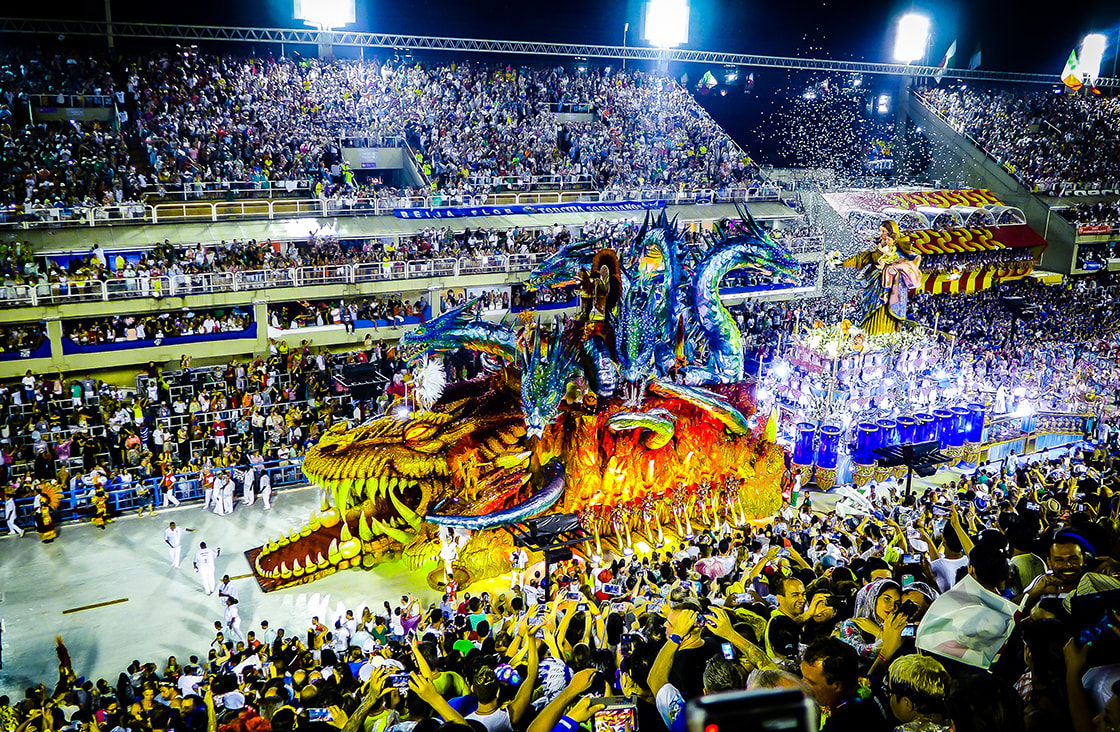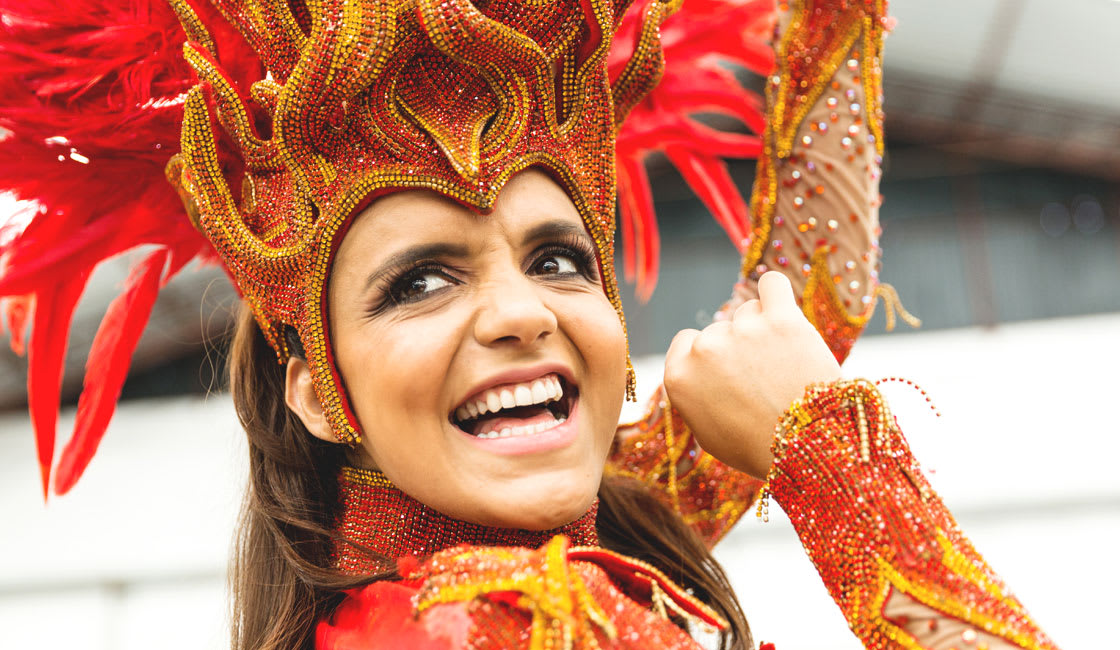
Every year for a week in February, Brazil is taken over by the wild, exuberant and pulsing display that is Carnival. Meant to celebrate the beginning of Catholic Lent, it’s perhaps most well-known for being an incredible spectacle of samba dancing, live music in the streets, world-class parades, colorful costumes, and vibrant revelry. Carnival in Brazil is the most popular time to visit the country, and is an experience that captures the essence of the lively Brazilian culture unlike any other. Think Mardi Gras turned all the way up… with a ton of Latin flair!
Celebrated between the Friday before Ash Wednesday and Ash Wednesday itself (51 days and 45 days before Easter respectively), you’ll find Carnival happening all over Brazil, yet the festivities in Rio de Janeiro and Salvador de Bahia are by far the largest celebrations. For 2024 Carnival falls between the afternoon of Friday 9 February and midday on Wednesday 14 February, and for 2025 it falls between the afternoon of Friday 28 February and midday on Wednesday 5 March.

Samba Dancer
In the city of Rio de Janeiro, there are essentially two Carnivals taking place at once. The most famous version of Carnival is the world-class parade that takes place in the Sambodrome in Rio de Janeiro. The 13-block long outdoor amphitheater is one of the city’s proudest sites, and visitors can book seats or boxes to watch the over-the-top ‘trios elétricos’ (floats with high-powered sound systems) parade through the middle, covered in hundreds of dancers and musicians. The costumes are remarkably elaborate, and every group competes to win title for best dance, music and design. This event lasts well into the night, and continues for three nights until all of the groups have performed and a winner is crowned. This performance is unlike any other show in the world and a one you certainly won’t want to miss. If you’re up for the ultimate experience, you can even pay to join in the parade one night!
The other version of Carnival in Rio de Janeiro is the people’s party which is a series of street parades and concerts in various neighborhoods throughout the city all day, every day. These events are called blocos (street parties), and range drastically in size, style, and crowds. Each bloco is arranged by a different samba group that has the same theme, time and location each year. Some are on small neighborhood streets with maybe 75 people. Some take place in the city center and draw crowds of up to 1 million. You’ll find something for everyone on the streets during Carnival, and while it can be a bit hectic, is always fun to experience at least once to get an idea of how the locals are celebrating.

Streets in Carnival
The Carnival in Salvador de Bahia follows a similar concept, but has a very different style from the Carnival in Rio de Janeiro. Due to the Afro-Brazilian culture of the Northeastern state of Bahia, you’ll hear more than just samba here. Reggae, samba-reggae, and music using some more traditional instruments are common additions. The events that take place in the Salvador Carnival are more of a combination of the two types in Rio de Janeiro mixed into one big parade. Like the blocos of Rio de Janeiro, the Salvador Carnival parade takes place on the streets, and it’s possible for visitors to dance alongside the performers. However, like the Sambodrome in Rio, the street parade is organized into one big event that follows one parade route so visitors also have the option of renting a VIP box or seats and enjoying the show more comfortably.
Other popular Carnivals in Brazil take place in the state of Pernambuco and São Paulo. In Pernambuco you’ll find major Carnival celebrations in the capital of Recife and the colonial town of Olinda. Here, the style of dance is largely African-influenced, and events are much more informal. All events take place in the morning, unlike the all day and night parades in Rio and Salvador, and they do not include any group competitions like the aforementioned cities.
Carnival in Sao Paulo takes place in the Anhembi Sambodrome in São Paulo, two days before the similar parade in Rio de Janeiro. Similarly, many different groups compete with wild floats, dancers, music and costumes for the highly-sought-after winning title. For those who love this type of performance, it’s possible to see the São Paulo parades on Friday and Saturday night, then make it to Rio de Janeiro for the primary Sunday and Monday night parades.

Sambadrome
Being the most famous holiday in Brazil, Carnival draws over a million tourists every year (1.5 million flocked to Rio de Janeiro alone for Carnival in 2019; Salvador around 800k). So, if you plan to visit any of the more popular destinations, you’ll definitely want to start planning in advance!

If you plan to visit Rio de Janeiro or Salvador Carnival, it is recommended to book flights and accommodation about 4-6 months in advance. If you plan to attend the Samba Parade, try to book these tickets shortly after your main travel plans. While there will usually be a few tickets up to the last couple weeks, the best tickets sell out early and prices can increase significantly as the date approaches. If you want to walk in the Sambodrome parade in Rio, you will need to book those tickets about 6 months before as spaces are very limited (also keep in mind that you will need a couple additional days in Rio to pick up costumes and practice- make sure to factor this in when booking your flights, etc!).
If you’re planning to visit one of the other Carnivals, it is still advisable to begin booking flights and accommodations around 4 months in advance, but it’s a bit more flexible.

Many guests enjoy combining a Brazilian Amazon cruise with their carnival trip. There are many different types of boats and itineraries to choose from. Whichever city you visit, or however you participate, you can be guaranteed that a trip to any Carnival in Brazil will be unlike any other experience!
While Rainforest Cruises aim to provide accurate and up-to-date information, we make no representations as to the accuracy or completeness of any information herein or found by following any link on this site. Rainforest Cruises cannot and will not accept responsibility for any omissions or inaccuracies, or for any consequences arising therefrom, including any losses, injuries, or damages resulting from the display or use of this information.




